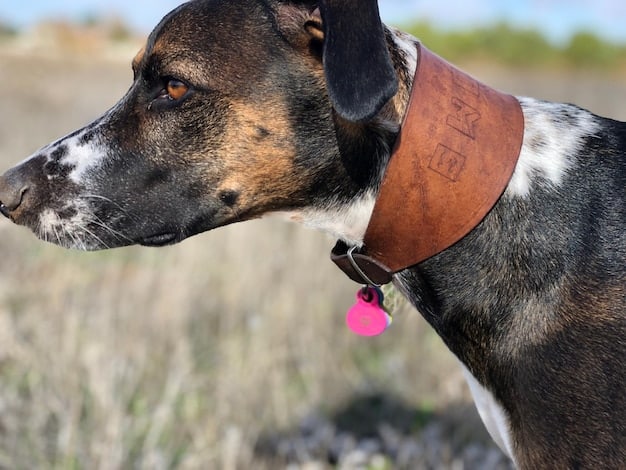Pet Safety During Disasters: Your Complete Guide

Pet safety during disasters is crucial, requiring preparedness, emergency kits, identification, evacuation plans, and post-disaster care to ensure your animals’ well-being during unforeseen events.
Ensuring pet safety during disasters is paramount. This guide equips you with essential strategies to prepare for and protect your beloved animals during emergencies, making sure they stay safe and secure when it matters most.
Understanding the Risks: Common Disasters Affecting Pets
Disasters can strike with little to no warning, and understanding the specific risks in your area is the first step in ensuring pet safety during disasters. Different types of emergencies require different preparations, so identifying potential threats is essential.
Natural Disasters
Natural disasters such as hurricanes, earthquakes, floods, and wildfires can pose significant threats to pets. Each type of disaster presents unique challenges.
- Hurricanes: Heavy rains and strong winds can cause flooding and structural damage, making evacuation necessary.
- Earthquakes: Ground shaking can lead to injuries from falling debris, and pets may become disoriented and lost.
- Floods: Rising waters can quickly inundate homes, requiring immediate evacuation to higher ground.
- Wildfires: Smoke and flames can be deadly for pets, and evacuation may be necessary to avoid respiratory issues and burns.

Man-Made Disasters
Man-made disasters like house fires, chemical spills, and explosions can also endanger pets. Being prepared for these events is crucial.
- House Fires: Smoke inhalation and burns are major risks. Working smoke detectors and a clear escape plan are essential.
- Chemical Spills: Exposure to hazardous materials can cause severe health problems. Knowing evacuation routes and emergency contacts is vital.
- Explosions: Shockwaves and debris can cause physical injuries and trauma. Safe shelters and immediate evacuation protocols are necessary.
Identifying the specific risks in your area and understanding the potential impact on your pets is the first step in effective disaster preparedness. Awareness allows for targeted planning and preparation, significantly improving your pet’s chances of staying safe during an emergency.
Creating a Pet Emergency Kit
A well-stocked pet emergency kit is a cornerstone of pet safety during disasters. Having essential supplies readily available can make a significant difference during evacuations or when resources are scarce. This kit should be easily accessible and portable.
Essential Supplies
Your pet emergency kit should include items that cater to your pet’s specific needs, ensuring their health and comfort during a crisis.
- Food and Water: Store at least a three-day supply of non-perishable food and bottled water for each pet.
- Medications: Include any necessary medications, along with copies of prescriptions and veterinary records.
- First Aid Kit: A pet-specific first aid kit should contain bandages, antiseptic wipes, and any other necessary medical supplies.
- Leash and Carrier: A sturdy leash and a secure carrier are crucial for safe evacuation and transport.
Additional Items
Beyond the essentials, certain additional items can provide extra comfort and security for your pets during stressful situations.
- Comfort Items: Include familiar toys, blankets, or bedding to help reduce anxiety.
- Sanitation Supplies: Pack waste bags, litter boxes (for cats), and cleaning supplies to maintain hygiene.
- Identification: Ensure your pet has proper identification, including tags, microchips, and recent photos.
Regularly checking and updating your pet emergency kit is essential. Replace expired food and medications, and ensure all items are in good working condition. Keeping your kit organized and easily accessible will help you respond quickly and effectively during a disaster.
Identification is Key: Microchipping and Tags
Proper identification is a fundamental aspect of pet safety during disasters. In the chaos of an emergency, pets can easily become separated from their owners, making identification methods crucial for reunification.
The Importance of Microchipping
Microchipping is a permanent form of identification that can significantly increase the chances of reuniting with your pet if they get lost.
- How it Works: A small microchip is implanted under your pet’s skin, containing a unique identification number.
- Registration: This number is registered in a national database, linked to your contact information.
- Reunification: If your pet is found, a veterinarian or animal shelter can scan the microchip and contact you.
Visible Identification: Tags
While microchipping is essential, visible identification tags are also important for immediate identification.

- Collar Tags: Ensure your pet wears a collar with a durable tag containing your name, phone number, and address.
- Additional Information: Consider including information about any medical conditions or special needs on the tag.
- Regular Checks: Periodically check the tag to ensure it is legible and securely attached to the collar.
Combining microchipping with visible identification tags provides a comprehensive approach to pet safety during disasters. Microchips offer a permanent solution, while tags allow for immediate contact if your pet is found. Keeping your contact information up-to-date in both the microchip registry and on the tags is essential for successful reunification.
Evacuation Plans: Knowing When and How to Leave
Having a well-defined evacuation plan is critical for pet safety during disasters. Knowing when and how to evacuate can save valuable time and ensure that you and your pets can leave safely.
Assessing the Situation
Being able to quickly assess the situation and determine whether evacuation is necessary is the first step in a successful evacuation plan.
- Stay Informed: Monitor local news, weather alerts, and emergency broadcasts for up-to-date information.
- Heed Warnings: Pay attention to evacuation orders and advisories issued by local authorities.
- Trust Your Instincts: If you feel unsafe, it’s better to evacuate early rather than waiting for an official order.
Evacuation Strategies
Developing a clear evacuation strategy that includes routes, transportation, and temporary shelter is essential for ensuring the safety of your pets.
- Plan Your Route: Identify multiple evacuation routes in case your primary route is blocked.
- Transportation: Ensure you have a reliable means of transportation, whether it’s your own vehicle or a pre-arranged ride.
- Pet-Friendly Shelters: Research local pet-friendly shelters or hotels along your evacuation routes.
- Emergency Contacts: Keep a list of emergency contacts, including veterinarians and animal shelters, readily available.
Practicing your evacuation plan with your pets can help reduce stress and ensure a smoother process during an actual emergency. Familiarize your pets with their carriers and the sound of your vehicle, and conduct regular drills to reinforce the plan. Preparation and practice are key to ensuring a safe and efficient evacuation.
Finding Pet-Friendly Shelters and Hotels
Securing pet-friendly accommodations is a crucial component of pet safety during disasters when evacuation is necessary. Knowing where you can safely house your pets can alleviate significant stress during an already challenging time.
Researching Pet-Friendly Options
Before a disaster strikes, take the time to research and identify pet-friendly shelters and hotels in your area and along potential evacuation routes.
- Local Shelters: Contact local animal shelters and emergency management agencies to inquire about pet-friendly shelter options.
- Hotel Chains: Many hotel chains have pet-friendly policies. Check their websites or call ahead to confirm their pet policies and any associated fees.
- Online Directories: Utilize online directories and websites that list pet-friendly accommodations.
Preparing for Shelter or Hotel Stays
Once you’ve identified potential pet-friendly options, take steps to prepare for a stay, ensuring your pet’s comfort and safety.
- Vaccination Records: Keep copies of your pet’s vaccination records, as many shelters and hotels require proof of vaccinations.
- Medications: Bring any necessary medications, along with prescriptions and instructions for administration.
- Comfort Items: Pack familiar toys, blankets, and bedding to help your pet feel more secure in a new environment.
- Contact Information: Ensure your pet’s identification tags include up-to-date contact information.
Having a pre-arranged plan for pet-friendly shelter during an emergency can provide significant peace of mind. Knowing that you have a safe place to take your pets can reduce stress and allow you to focus on other essential tasks during a disaster.
Post-Disaster Care: Reunification and Recovery
The period following a disaster is critical for ensuring pet safety during disasters and facilitating reunification with lost pets. Returning to normalcy requires careful planning and attention to your pet’s physical and emotional well-being.
Searching for Lost Pets
If your pet becomes lost during a disaster, taking immediate action to search for them is essential.
- Local Shelters: Visit local animal shelters and humane societies to check if your pet has been found.
- Online Resources: Utilize online lost and found pet websites and social media groups to post photos and information about your missing pet.
- Community Assistance: Enlist the help of neighbors, friends, and community members to search the area.
Reunification Strategies
Once your pet is found, taking steps to ensure a smooth and stress-free reunification is crucial.
- Calm Environment: Create a calm and quiet environment to minimize stress for your pet.
- Familiar Items: Provide familiar toys, blankets, and bedding to help your pet feel more secure.
- Veterinary Check-Up: Schedule a veterinary check-up to assess your pet’s physical condition and address any medical needs.
- Behavioral Support: Monitor your pet’s behavior for signs of trauma or anxiety, and seek professional help if needed.
The recovery process following a disaster can be challenging for both pets and their owners. Providing a safe, supportive environment and addressing any physical or emotional needs are essential steps in helping your pets return to their normal routines. Patience, understanding, and proactive care can significantly contribute to a successful recovery.
| Key Point | Brief Description |
|---|---|
| 🚨 Disaster Knowledge | Understand local disaster risks like hurricanes, earthquakes, and fires to tailor your pet safety plan for specific threats. |
| 🎒 Emergency Kit | Prepare a three-day supply kit with food, water, meds, first aid, leash, and carrier for quick evacuation. |
| 🆔 Identification | Microchip your pet and use visible ID tags with current contact info to ensure they can be identified if lost. |
| 🏨 Pet-Friendly Shelter | Research pet-friendly shelters and hotels in your area to ensure you have safe evacuation options. |
Frequently Asked Questions
▼
Common disasters include hurricanes, earthquakes, floods, wildfires, house fires, and chemical spills. Each poses unique threats to pet safety.
▼
Include a three-day supply of food and water, medications, a first aid kit, leash, carrier, comfort items, and sanitation supplies.
▼
Microchipping provides a permanent form of identification, increasing the chances of reuniting with your pet if they get lost during a disaster.
▼
Research local animal shelters, hotel chains, and online directories that list pet-friendly accommodations in your area and along evacuation routes.
▼
Visit local shelters, use online resources, and seek community assistance to search for your missing pet and facilitate reunification.
Conclusion
Being prepared is essential for ensuring pet safety during disasters. By understanding potential risks, creating an emergency kit, ensuring proper identification, developing evacuation plans, and knowing where to find pet-friendly shelter, you can significantly increase your pet’s chances of staying safe during unforeseen events. Taking these proactive steps provides peace of mind and safeguards the well-being of your beloved animals.





